



 |  |  | |||||||
 |
Home | Newsletters | Links | Train Simulator | |||||
Technical |
The Weardale and Teesdale Network |
Scenarios |
Offer |
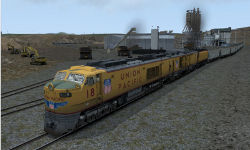
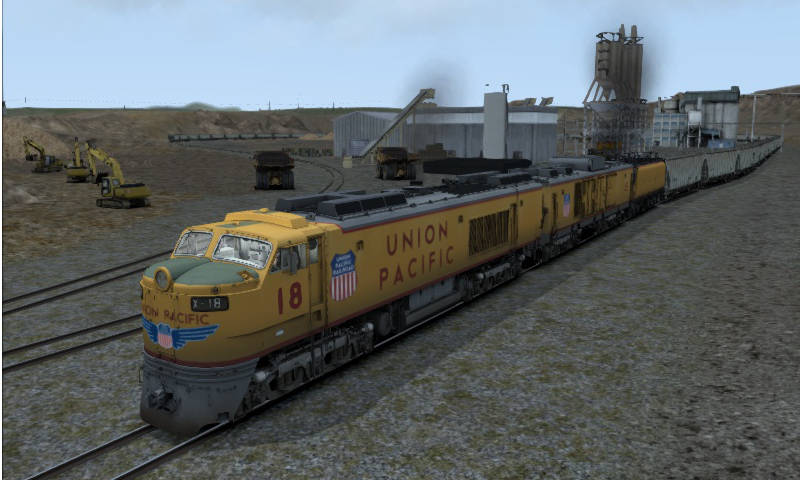
The Big Blow at Granite. The 8,500hp GT-Electric, also known as the bird-burner, about to set off from Granite with a rake of stone hoppers. The third unit is the fuel tank for the gas-turbine. Yes- that is the rear of the train in the background.
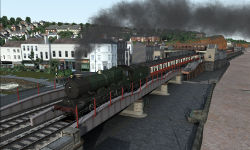
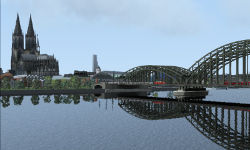
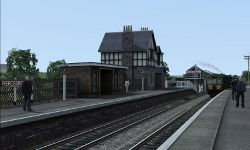
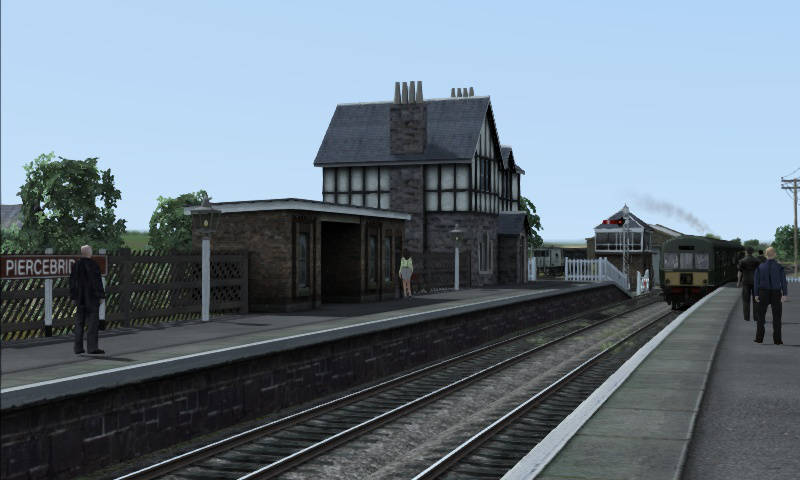
Piecebridge. An afternoon service from Barnard Castle to Darlington arrives. Today the Station building and platforms are gone but the Stationmaster’s house remains as do some of the other buildings adapted for housing.
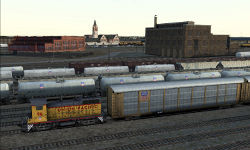
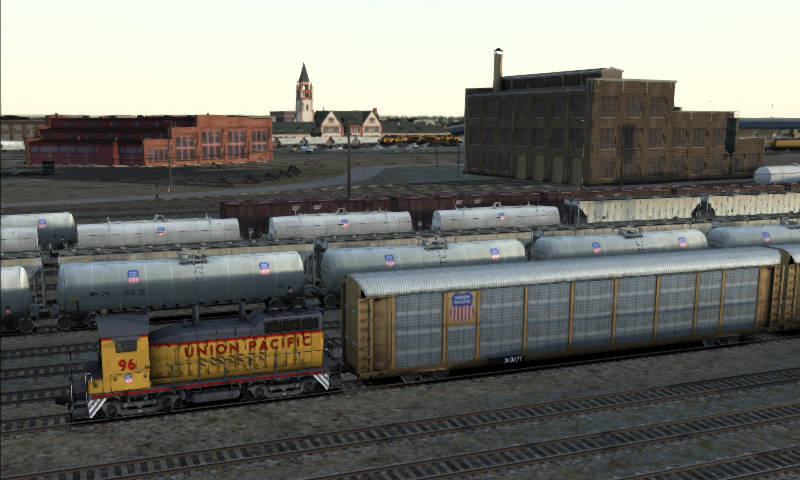
Cheyenne. Shunting (or switching) in the yard beside the roundhouse and Diesel shed with a long train of hoppers passing in the background.
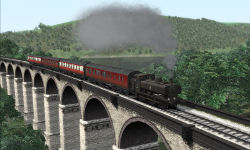
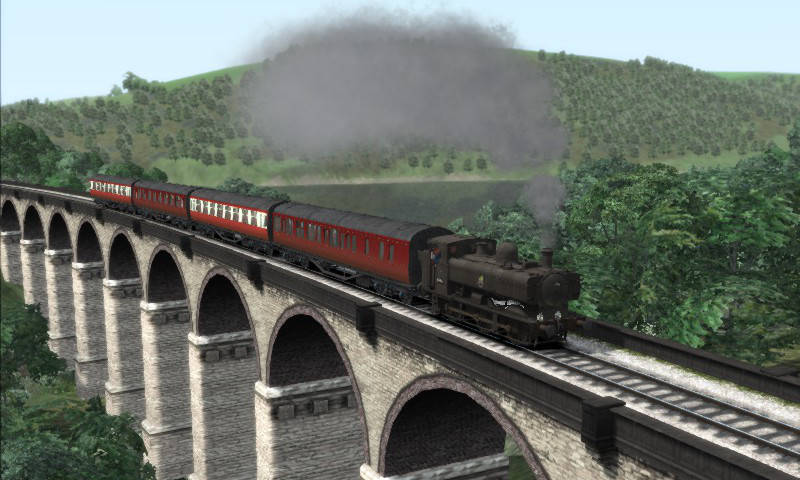
Greenway Viaduct. A pannier tank on Greenway Viaduct as it climbs up from Kingswear on a stock movement with the Dart in the background. The line from Kingsear to Paignton is now the Dartmouth Steam railway.
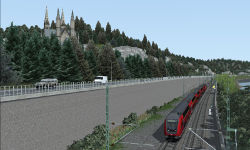
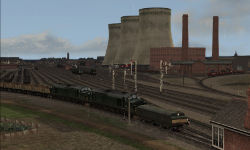
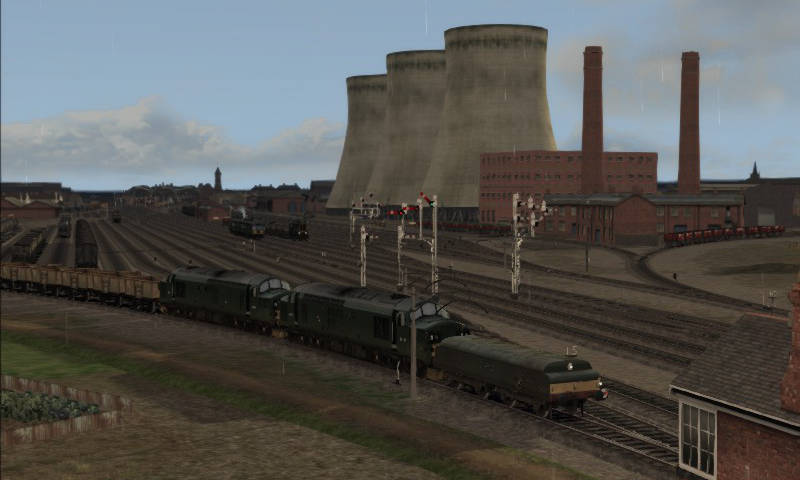
Darlington Bank Top. A view from the bridge over Parkgate Junction. Most of the extensive trackwork is gone as is the power-station. Indeed the station, in the distance with its distinctive clock-tower, is one of the few recognizable reference points remaining. The two Type 3s are pushing a brake tender. At a time when most freight wagons were unfitted it was thought that Diesels, which are lighter than a steam loco’ of equivalent power, might be lacking in brake force hence the creation of these ungainly vehicles but it was soon realized that they were unnecessary.
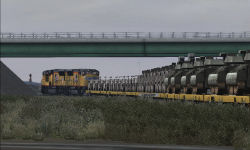
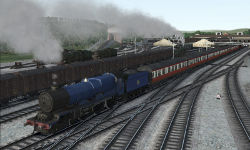
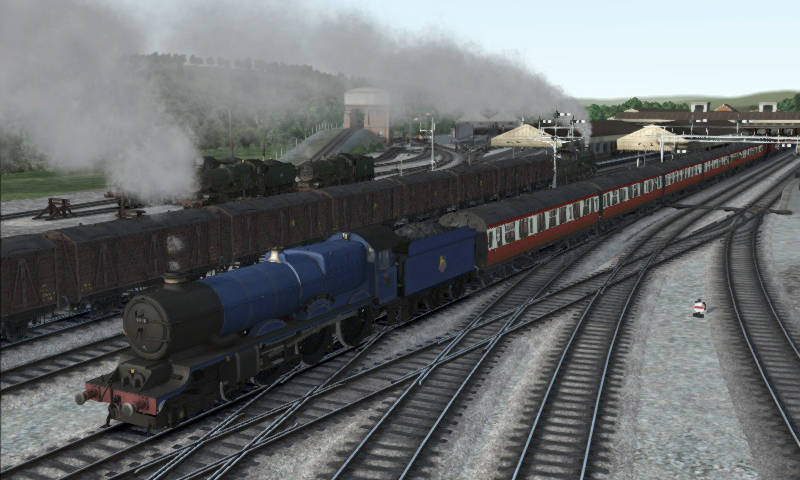
Exeter St. Davids. King Class 6018 King Henry VI, in the attractive but short-lived BR Express Blue livery, departs as 6818 Eastbury Grange passes on less glamorous duties.
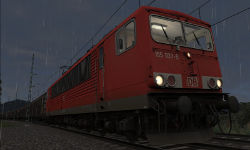
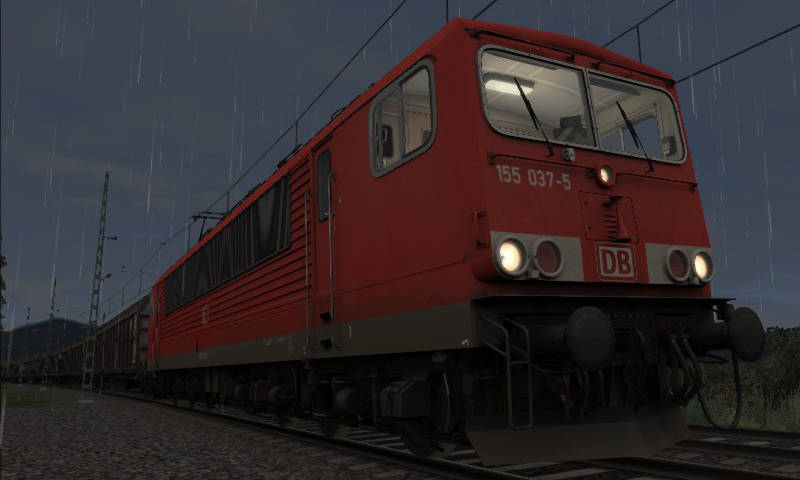
DB155. One of the archetypal DB electrics works through a storm between Bonn-Mehlem and Oberwinter.
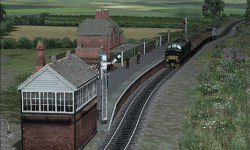
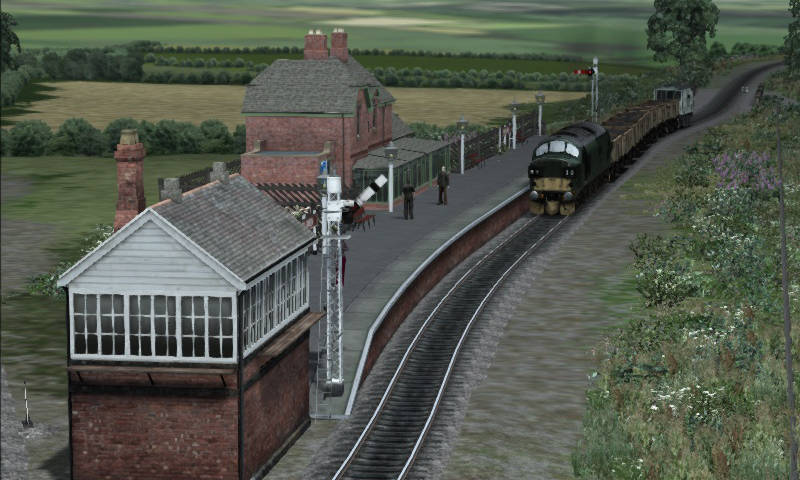
Byers Green Station. The trackbed of the line is now the Auckland Way Path between Bishop Auckland and Spennymoor. Unlike Coundon Station, the next stop, the buildings are gone with only the remains of the platform to mark its location.
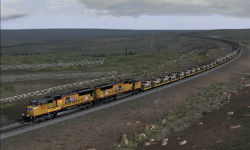
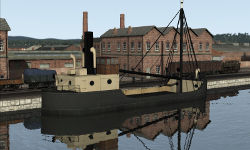
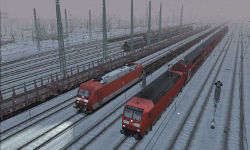
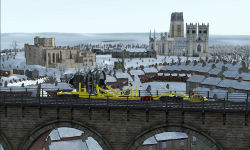
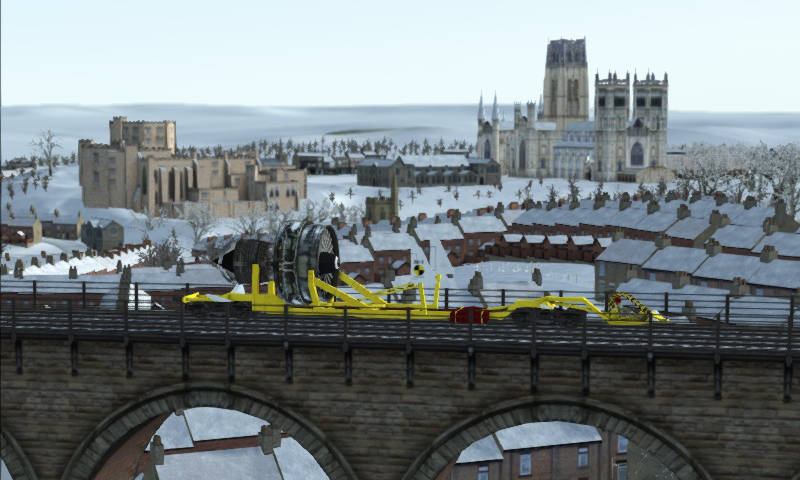
Hey y'all- Watch This! The mad, bad and extremely dangerous to be anywhere near Jet Train (basically a jet engine on a couple of bogies) crosses Durham Viaduct. There were no survivors.
This description of Train Simulator 2016 is largely based on the feature that originally appeared in the Friends of Darlington Railway Museum Newsletter. Some changes have been made to reflect developments and further experience with the program. Inevitably it has to include some discussion of hardware but this is a site for rail enthusiasts in general and members of the Friends of Darlington Railway Museum in particular and is written for readers who are unlikely to be particularly interested in or knowledgeable about computers or games. All of the pictures used to illustrate this section of the site are screen grabs from Train Simulator itself with the game running at the highest level of detail but a relatively low resolution of 800x600 pixels.
The line between games and simulators is somewhat blurred. Simulators are serious tools used to train surgeons, engineers, pilots, ship captains, racing drivers and indeed train drivers with the environment reproduced in as much detail as possible including realistic controls. Train Simulator (TS as I shall refer to it henceforth) aims to do the same within the limitations imposed by running on ordinary home computers but with the budget and some know-how you could immerse yourself further in the environment perhaps with a customized control panel and extra screens. There is a scoring system but it is a means of gauging your performance- no bonuses for collecting coins, running people over at level crossings or other such nonsense.
Crucially, although it is a serious program, serious is not the antithesis of fun and TS is meant to be fun- at least for those who share our interests. I suspect most people reading this will have driven trains or would give their eye-teeth to do so and TS is for them. Typically each edition of the program comes with three routes (the 2018 edition included four) and local editions add one or two more to the basic package. A route can be a line or an area with several individual lines and will include a locomotive and enough rolling-stock to make up trains or, at the very least, a multiple unit so you have something to drive in it and a few scenarios which set out some objectives. TS 2016 comes with the following:
Once TS is installed, a process described in detail here, you can jump in at the deep end by clicking Drive, choosing a scenario and driving one of the routes if you wish but an Academy section allows you to learn the basics with the computer advising you. PDF manuals installed with the game help but consulting them while using the program will not be easy unless you have a second device to read them on but tablets and smart 'phones are so common these days that is actually quite likely. Whatever you choose to do there will be a wait while all the needed data is loaded and the simulation is set up. How long this takes will vary depending on what sort of hardware you have and the route being used.
An overlay or "Head Up Display" (HUD) at the bottom of the screen has the main controls and some information about the train and route ahead including speed limits and signal locations (but not settings) and you can use it to control your train no matter your point of view. Viewing options include Line-side (view your train from a series of fixed points as it passes), Helicopter (follow usually from above though you can view from any angle as long as the ground is not in the way) and Free (move around the world almost irrespective of your train). The HUD does alter to suit the traction- regulator and reverser for steam, a notchy throttle and gears for a Modernization Plan DMU and so forth but it does standardize the control layout to some extent which makes adapting to one locomotive from another easier. Without the HUD (and you can turn it off) you need to know the route and keep your point of view in the cab to see meters and gauges. When in the cab the controls are part of your view and you can move them with the mouse but I found that very imprecise. It would be better to get used to the keyboard or a game controller- personally I like to use the keyboard controls with the HUD open as my "dashboard". Even using the HUD I found steam locomotives hard to get to grips with, although this may be because the first steam scenario in the Riviera route is quite tricky, but the computer can do the fireman's job (in fact why is that not on by default?) and driver advice saw me through. These options (including driver advice) are available throughout the game.
Included with the Friends' offer is The Weardale and Teesdale Network in the '60s route (described in greater detail here). It comes with a 1950s Metro-Cammell Class 101 DMU. As my train driving experience consists entirely of about 18 miles in the Wensleydale Railway's Class 101 a few years ago (and since the scenarios involving the DMU are rated easy) I began with a scenario driving this. I was genuinely surprised and delighted by how familiar everything seemed and how right the unit's response to the controls felt. It sounds good as well from the engines and whooshing of brakes to the clicking of the pneumatic system as you change gear. I have no experience to compare other units and locomotives against but they sound right and overall I found the driving experience very satisfying.
Career and Standard scenarios are rated for difficulty and it seems natural to start with the easier ones but there is no onus to attempt them in any particular order. Both set an objective or series of objectives which may be to make a journey or do some shunting. In Career scenarios you score points, or lose fewer, if you keep to your timetable or buffer up gently. At the end, presuming you reach the end, there is a report and your score usually out of 1,000- anything less and the report tells you why. If a Career scenario is part of a DLC sold by Dovetail through Steam your score also gets added to an overall Career total the purpose of which is unclear since it does not appear to count towards anything. Standard scenarios work in the same way but there is no scoring and passing a signal at danger, which would end your game in a Career scenario, can be overlooked.
Free Roam scenarios are open ended and rather freewheeling something like running a model railway. You start in free camera mode and can click on any train or locomotive you fancy and just drive it setting the points as you go to travel where you wish. You can stay in one train or switch to another by clicking on it and, as long as you don't derail or knock anything else off the rails, you can carry on for as long as you like doing as you please. I have hardly used FreeRoaming but other users swear it is the best thing about TS.
There is a Quick Drive option where you just pick a locomotive, a route and start and end points. The path is set for you and there is nothing to run into so it's not a bad way to become familiar with a route. Not all locomotives and routes are compatible with Quick Drive but from those that are you can choose to drive whatever you want wherever you want with some sensible limitations. You cannot run an electric locomotive where there is no catenary or third rail for example. You can start a Castle from the summit of Sherman hill and have a crack at Mallard's record. 145mph since you were wondering.
An editor enables you to set up your own Career, Standard or Free Roam scenarios while others, created by TS players, can be downloaded from the Workshop section of Steam for free. One restriction with the Steam Workshop downloads is that they must be created using items made by Dovetail Games or sold by them through Steam. These items can be mixed and matched to one's heart's content- if you want to drive a pannier tank to Köln you can go right ahead and set that up then upload it to the Workshop and, as long as another user has all the items they need in their collection (called the dependencies because a scenario depends on them to run as intended), they can run it. As you might expect then some Workshop scenarios can be on the fanciful side but most are plausible if not actually derived from time-tables and traffic research. The degree of expertise evinced by scenario creators does vary as does the level of detail with some authors setting up other train movements around you which may or may not effect you directly but do add to the atmosphere. The editing system even gives ambitious users the tools to create their own routes using components from routes in their collection which can also be uploaded to the Workshop. The same caveats about what can be used to make the route and how dependencies work for other users hold true here.
As well as the manual there are guides to be found in Steam and plenty of tutorial videos in YouTube that go into far more detail about the editor than could ever be included here. The fact is that most people wishing to expand their horizons will do it the easy way with downloadable add-ons (DLC for DownLoadable Content) in the form of new routes and stock. Routes have already been described while a locomotive DLC is likely to include some new scenarios that you can run if you have the right route already installed- it might also add some suitable rolling stock to your collection to go with it. Coaching and freight stock, scenery items for route builders, new liveries for vehicles and collections of scenarios for a route may also come in the form of DLC. One could spend hundreds or even thousands of pounds on DLCs (or DLC... I am conscious of the potential for confusion caused by referring to downloadable content in general as DLC and items of downloadable content as a DLC or DLCs but trust that the distinction is not too hard to follow in context). This is not to say that they are expensive, especially given the amount of work that clearly goes into them, but that there are many.
As has been mentioned TS and content available for it is developed and sold by Dovetail Games with distribution handled by Valve through it's Steam application. Dovetail also sells some content produced by other developers but is not the only source of content for TS- indeed the array of routes, rolling stock and other goodies available from third parties may well exceed the wares listed by Steam. You would have to look for it and installation is not quite as straight-forward as buying through Steam which automatically sets things up for you but, with instructions, it should not be at all difficult. Particularly impressive is the Stainmore, Shap and Eden Valley route from Steam Sounds Supreme which compliments Dovetail's own Weardale and Teesdale Network.
Some free DLC is available and at this point it's worth mentioning TS Rewards which ran for a few months after the release of TS2016. Users could register with Dovetail Games and would receive a DLC every month which was suitable for one or other of the 2016 routes. The scheme ran its course and the free items have since been included with the routes. They should have been either sent as updates to users who already had the routes or included from new but the updating process doesn't seem to be entirely reliable so if you take up the offer here or own any of the three routes mentioned above look in the Train Simulator section of your Steam Library (that will make sense if you get the game) to see if the TS Rewards items are listed there. If not Dovetail will send them to you for the asking.
The first version of TS was released in 2009 and developed from a program that was older than that. This is positively geriatric in gaming terms and it does show. I am not much of a gamer but I am aware that TS does not really compare graphically to modern games Dovetail's newer title Train Sim' World being an obvious comparison- the graphics are adequate rather than stunning. Smoke from a steam locomotive will go through a bridge rather than billowing around it. In Quick Drive you can take the enormous Union Pacific loco's along the Riviera even though they are hopelessly out of gauge fouling platforms, bridges and other line-side features which they simply pass through in ghostly fashion. At a station passengers appear out of thin air, occasionally walk in the platform rather than on it and are clearly based on a few stock figures albeit with different coloured clothes. You will also notice that trains often have a crew and passengers aboard even when they are parked in sidings in the middle of the night. It keeps things simpler and people are best considered part of the scenery.
One issue that gets quite lot of comment is tile stutter. TS does not set up an entire route in memory at the start of a scenario- that would take ages and an improbable amount of RAM. Instead routes are divided into sections (tiles) and just the tiles centred on your location are loaded. As you proceed it loads in the tiles that make up the scenery ahead of you. This process could be handled smoothly by loading the tiles in advance and buffering them in memory but when TS was new the average PC did not have the resources to do that so there is a noticeable slow-down when it happens. Hard disk drives have been largely superseded as main storage devices by Solid State Drives (SSDs) which use a type of computer memory. Because they don't have a seek time (the time it takes for the physical mechanism of an HDD to locate data) they are intrinsically faster. SSDs that use an NVMe interface attached directly to the PC's motherboard instead of the older SATA standard are faster again- several times faster than any HDD you would be likely to find in a home PC. Any speed up will help with tile stutter (as well as reducing start-up and loading times in general) but one is unlikely to get rid of it entirely.
TS is not going to get much better in this respect. PCs are orders of magnitude more powerful than they were ten years ago but making huge changes to take advantage of that would be difficult and doing so without breaking compatibility with the routes and rolling stock that some users have spent years collecting and driving nigh on impossible. Dovetail has instead opted to develop a new program TSW (Train Sim' World) but TS remains current. The fact that its users, whilst not blind to its faults, continue to use TS and buy new trains and routes should tell you something about how good it is in the first place.
If you are interested you can read more about the technical side of the program and my experience with it here. I have been using Train Simulator since 2015 but have still not tried using the editing functions to create new routes or scenarios and I barely understand the DB signalling system. For the first year at least I was happy enough driving around the Weardale and Teesdale Network. Now I have around thirty routes some of which I have explored while others I look forward to getting to know and for the most part I have been thoroughly entertained.
If you are a member of the Friends of Darlington Railway Museum and this description has aroused your interest the offer of a free copy of Train Simulator 2016 including the Weardale and Teesdale Network in the '60s is still open at the time of writing. Otherwise TS has an RRP of £29.99 and can be bought on disk or downloaded from Dovetail Games or Steam. The Weardale and Teesdale pack is £24.99 and only available by download. Other versions of TS are available which bundle different routes and rolling-stock and some DLCs are also sold in bundles. Special offers may apply to the program, DLCs or both. The Dovetail Games website is www.dovetailgames.com from which you can find the link to the Train Simulator page of Steam. There are many videos on YouTube and other sites showing gameplay footage and tutorials posted by dedicated users.